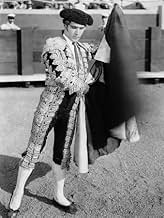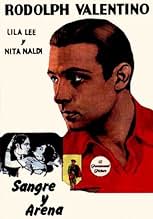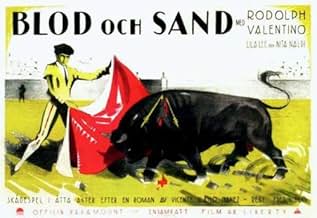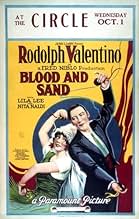IMDb-BEWERTUNG
6,3/10
1608
IHRE BEWERTUNG
Füge eine Handlung in deiner Sprache hinzuA toreador's (Rudolph Valentino) familial and social life is threatened when he has an affair.A toreador's (Rudolph Valentino) familial and social life is threatened when he has an affair.A toreador's (Rudolph Valentino) familial and social life is threatened when he has an affair.
- Regie
- Drehbuch
- Hauptbesetzung
- Auszeichnungen
- 1 wins total
Rudolph Valentino
- Juan Gallardo
- (as Rodolph Valentino)
Rosa Rosanova
- Angustias
- (as Rose Rosanova)
W.E. Lawrence
- Fuentes
- (as William Lawrence)
Michael Dark
- Doña Sol's New Lover
- (Nicht genannt)
Empfohlene Bewertungen
The color cinematography which won an Oscar and the outstanding performances of stars Tyrone Power, Linda Darnell, and Rita Hayworth made the sound remake of Blood And Sand an enduring classic. But this silent version and much shorter version of Vincente Blasco Ibanez novel has a lot going for it.
Mostly it has Rudolph Valentino going for it. Valentino is cast well as the champion bullfighter of Spain who rises from poverty and marries the girl next door. But then this Samson of the Corrida throws it all away for the love of the Delilah like Dona Sol.
Lila Lee is the girl next door who Valentino marries and silent screen temptress Nita Naldi plays the beautiful and cruel Dona Sol. That one gets Valentino definitely going south of his Mason/Dixon line. In that sense Blood And Sand was a perfect Valentino picture because it had Valentino for the women to swoon over and Naldi for the men to drool over.
I did miss Laird Cregar playing the epicene critic Curo from the sound version. On the other hand there's Walter Long playing a bandit chief whose life as a lot of parallels to that of protagonist Juan Gallardo.
One thing that is radically different is that this silent version takes a position most against the sport of bullfighting. I'm betting that it was not popular in Spain or with Ernest Hemingway. The sound version has far more macho approach.
You'll have to decide for yourself which is better.
Mostly it has Rudolph Valentino going for it. Valentino is cast well as the champion bullfighter of Spain who rises from poverty and marries the girl next door. But then this Samson of the Corrida throws it all away for the love of the Delilah like Dona Sol.
Lila Lee is the girl next door who Valentino marries and silent screen temptress Nita Naldi plays the beautiful and cruel Dona Sol. That one gets Valentino definitely going south of his Mason/Dixon line. In that sense Blood And Sand was a perfect Valentino picture because it had Valentino for the women to swoon over and Naldi for the men to drool over.
I did miss Laird Cregar playing the epicene critic Curo from the sound version. On the other hand there's Walter Long playing a bandit chief whose life as a lot of parallels to that of protagonist Juan Gallardo.
One thing that is radically different is that this silent version takes a position most against the sport of bullfighting. I'm betting that it was not popular in Spain or with Ernest Hemingway. The sound version has far more macho approach.
You'll have to decide for yourself which is better.
Impoverished shoemaker's son Rudolph Valentino (as Juan Gallardo) wants to be a bullfighter, much to his widowed mother's dismay. Still, toreador Valentino excels in the dangerous sport; and, later, he is wealthy and famous throughout Spain. Along the way, he marries virtuous childhood sweetheart Lila Lee (as Carmen). For Valentino, temptation accompanies fame, as he falls under the spell of wicked temptress Nita Naldi (as Doña Sol), a slightly sadomasochistic bullfighting groupie. Can Valentino love two women at the same time?
Valentino performs well as an innocent ragamuffin who achieves great fame; of course, this parallels the idolization of the film's star. Moreover, the Idol proves just as attractive being seduced (herein, by Ms. Naldi) as he was the seducer (in the recent "Sheik"). Fred Niblo's "Blood and Sand" is a classic; however, the story, and disjointed bullfighting footage, do bog things down.
Great things happen, after about a quarter hour, when Valentino steps into Naldi's lair. In a neat bit of acting business, Valentino wipes a sweaty hand before greeting his seductress; then, he and Naldi's servant exchange weird looks as Valentino gets his cigarette lighted. After some crosscutting to innocent Ms. Lee, Naldi's harp-playing gets her man.
Writer June Mathis adapts well, for her star; but, the Ibáñez story should have more streamlined. Combining, or further developing, the characters played by Charles Belcher (Don Joselito) and Walter Long (Plumitas) might have helped. Mr. Belcher's character is most interesting; he collects torture devices, and choruses the film's thesis: "Happiness and prosperity built on cruelty and bloodshed cannot survive."
******* Blood and Sand (8/5/22) Fred Niblo ~ Rudolph Valentino, Lila Lee, Nita Naldi, Charles Belcher
Valentino performs well as an innocent ragamuffin who achieves great fame; of course, this parallels the idolization of the film's star. Moreover, the Idol proves just as attractive being seduced (herein, by Ms. Naldi) as he was the seducer (in the recent "Sheik"). Fred Niblo's "Blood and Sand" is a classic; however, the story, and disjointed bullfighting footage, do bog things down.
Great things happen, after about a quarter hour, when Valentino steps into Naldi's lair. In a neat bit of acting business, Valentino wipes a sweaty hand before greeting his seductress; then, he and Naldi's servant exchange weird looks as Valentino gets his cigarette lighted. After some crosscutting to innocent Ms. Lee, Naldi's harp-playing gets her man.
Writer June Mathis adapts well, for her star; but, the Ibáñez story should have more streamlined. Combining, or further developing, the characters played by Charles Belcher (Don Joselito) and Walter Long (Plumitas) might have helped. Mr. Belcher's character is most interesting; he collects torture devices, and choruses the film's thesis: "Happiness and prosperity built on cruelty and bloodshed cannot survive."
******* Blood and Sand (8/5/22) Fred Niblo ~ Rudolph Valentino, Lila Lee, Nita Naldi, Charles Belcher
I've watched "Blood and Sand" several times; I own the DVD. With every viewing I notice some new subtle nuance in the under played gestures of Valentino. In the big seduction scene between Valentino and the voluptuous Nita Naldi, she sits at a harp, delicately playing, with her back to Valentino. He walks up behind her chair, clearly aroused, and he begins to seductively stroke the chair! This is so under played and yet so visually compelling and sensuous.It is so unlike the melodramatic rather hystrionic aesthetic so often found in films from this period. Valentino's restraint throughout the film's more emotional moments is compelling; his subtlety pulls the viewer intimately inward.True, the bull fighting scenes leave a bit to be desired. They are the result of some rather choppy editing and sadly come off looking peculiar,even humorous at times. Somehow Valentino pulls it off, his graceful movements, his quiet emotions, his compelling sensuality more than make up for the lack of authenticity in the bullring.
Although in many ways "Blood and Sand" looks rather old-fashioned now, it's still an interesting drama. It gives Rudolph Valentino one of his better roles, and it is also highlighted by an effective supporting performance from Nita Naldi. The subject matter has some substance to it, and it still holds up well enough despite being handled occasionally in a somewhat heavy-handed manner.
In playing the bullfighter Gallardo, Valentino gets a character with some depth to it. The story follows him as he first struggles to achieve fame and respect, and then struggles in dealing with the side-effects of fame, fortune, and popularity. Naldi's role is memorable, and from her first appearance she makes her manipulative vamp character physically desirable but an obvious source of danger. Valentino does a good job playing off of her, and even without the benefit of spoken dialogue it is easy to see the struggle and self-reproach taking place inside of him.
The themes have a significance that go beyond the original setting. In itself, the criticisms of bullfighting and of what it reveals about human nature, while generally quite valid, are put forth without any subtlety. The inter-titles and the obvious parallels between Gallardo and the notorious criminal Plumitas repeatedly emphasize the same points that the action itself could have made well enough on its own. But that's one of the few weaknesses of "Blood and Sand". And the more general point, its depiction of how easy it is for crowds to be thrilled with violence, is well-taken.
The one other noticeable shortcoming is that the bullring scenes are now often unconvincing. It is laudable, of course, that the film-makers were willing to sacrifice realism so as to avoid being cruel to the animals, so this particular aspect of the movie should be evaluated generously. Present-day technology would certainly have made it much simpler to achieve both goals.
Although the style might make it mostly of interest to those who are already silent movie fans, there is still more than enough of interest to make this worth seeing. The story is simple, but it has some worthwhile aspects. Naldi provides something striking to look at, and Valentino gets to show what he can do with a role that has some possibilities to it.
In playing the bullfighter Gallardo, Valentino gets a character with some depth to it. The story follows him as he first struggles to achieve fame and respect, and then struggles in dealing with the side-effects of fame, fortune, and popularity. Naldi's role is memorable, and from her first appearance she makes her manipulative vamp character physically desirable but an obvious source of danger. Valentino does a good job playing off of her, and even without the benefit of spoken dialogue it is easy to see the struggle and self-reproach taking place inside of him.
The themes have a significance that go beyond the original setting. In itself, the criticisms of bullfighting and of what it reveals about human nature, while generally quite valid, are put forth without any subtlety. The inter-titles and the obvious parallels between Gallardo and the notorious criminal Plumitas repeatedly emphasize the same points that the action itself could have made well enough on its own. But that's one of the few weaknesses of "Blood and Sand". And the more general point, its depiction of how easy it is for crowds to be thrilled with violence, is well-taken.
The one other noticeable shortcoming is that the bullring scenes are now often unconvincing. It is laudable, of course, that the film-makers were willing to sacrifice realism so as to avoid being cruel to the animals, so this particular aspect of the movie should be evaluated generously. Present-day technology would certainly have made it much simpler to achieve both goals.
Although the style might make it mostly of interest to those who are already silent movie fans, there is still more than enough of interest to make this worth seeing. The story is simple, but it has some worthwhile aspects. Naldi provides something striking to look at, and Valentino gets to show what he can do with a role that has some possibilities to it.
Most people picture Rudolph Valentino from his earlier roles in "Four Horsemen Of The Apocalypse" or "The Sheik". In this movie, Valentino plays a Matador in Spain and the story traces his rise and fall. Yes, he certainly was handsome and you see traces of his definate appeal here. For me, though, the movie was stolen by "the other woman", Dona Sol. She tarts her role up real well and plays it very broad, almost shockingly brazen for it's time. The scene where she tells Valentino that she longs to fell him beat her will make us wince, then she bites his hand while while in a semi-embrace in order to raise his passions. All stuff that seems pretty extreme for the typical innocent silent movie woman roles. The ending will be no surprise, it is telegraphed and alluded to many times during the movie. It's not Rudy at his absolute best, but I can recommend it.
Wusstest du schon
- WissenswertesThe film's editor was Dorothy Arzner, who would later go on to become Hollywood's first female director. Arzner impressed the producers by cannily interspersing stock bull-fighting footage with shots of Rudolph Valentino to make it look like the actor was actually in the ring with real bulls. This was quite a progressive technique in its day.
- PatzerThe mountain bandit who is one of the principal supporting characters is an anachronism; the Guardia Civil did away with their kind during the late 19th century.
- Zitate
Juan Gallardo: We spread our capes for your amusement and most generous alms.
- VerbindungenEdited into Michael Blanco (2004)
Top-Auswahl
Melde dich zum Bewerten an und greife auf die Watchlist für personalisierte Empfehlungen zu.
- How long is Blood and Sand?Powered by Alexa
Details
Box Office
- Bruttoertrag in den USA und Kanada
- 2.725.000 $
- Laufzeit1 Stunde 48 Minuten
- Sound-Mix
- Seitenverhältnis
- 1.33 : 1
Zu dieser Seite beitragen
Bearbeitung vorschlagen oder fehlenden Inhalt hinzufügen






































